Lechon asado, a Cuban Roast Pork, is slow-roasted to fall-apart tender after being marinated in a special mojo marinade for a whole night.
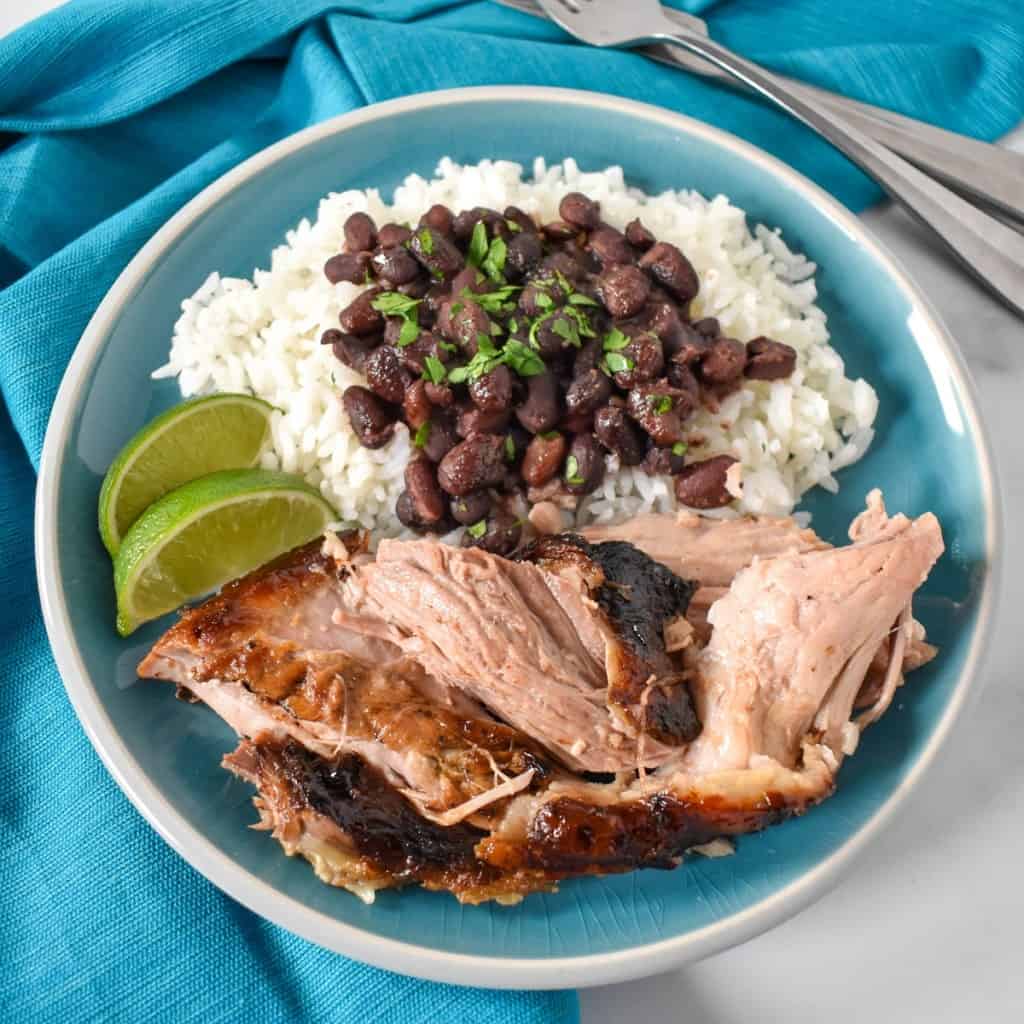
roast pork is the dish given on all significant occasions in Cuban culture. Roast pork is served during Christmas, New Year’s, weddings, and any other occasion. This is a classic dish that marinates in a homemade mojo sauce.
This lechon recipe yields an 8–10 pound big roast. For the sake of this recipe instructions, we advise sticking to that approximate size. Even though there is a lot of meat, it goes quickly, I promise.
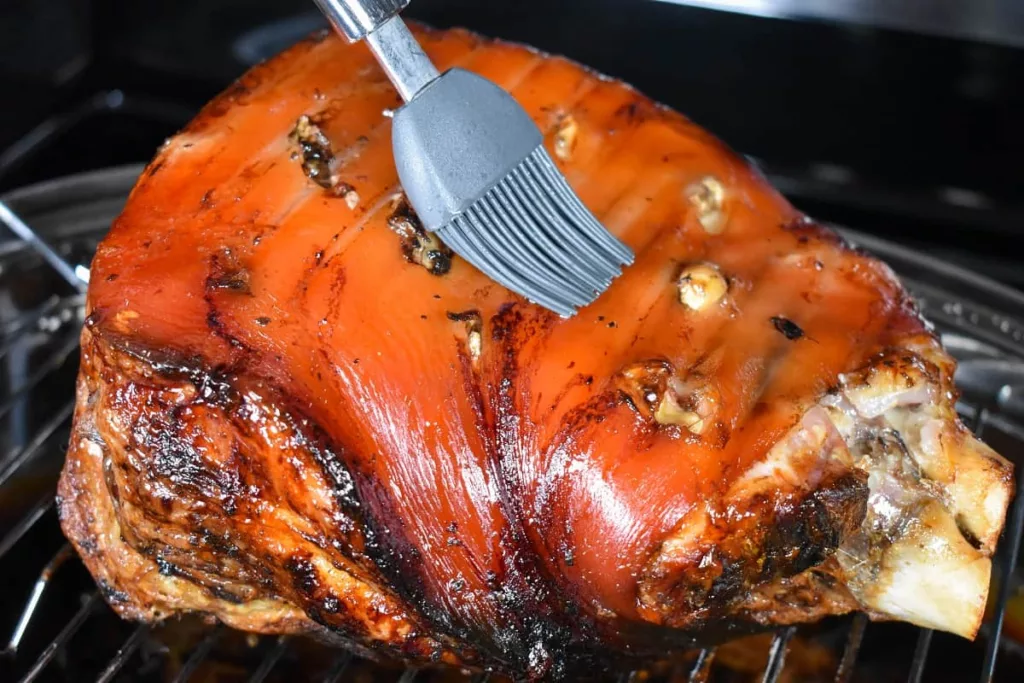
Cubaan roast pork is served over two days. The pork must marinade in the fridge for the entire night. Make sure to budget for the hours of low and slow roasting that follow.
Another thing to consider is that your house will smell fantastic while the pig is cooking, so bring lots of snacks on roasting day. Who knows when it will be ready? Everyone will want to know. “Is it prepared yet?” Have fun!
BEST CUT OF MEAT FOR ROAST PORK
Lechon means pork in Spanish. Leechon, often known as lechon asado, is the term for roasted pig marinated in mojo, a citrusy, garlicky sauce. Lechon can be prepared in a typical barbecue, an oven, a Caja China (an outdoor roasting box heated by charcoal), or as a full pig or a portion of the pig.
A portion of pork is grilled in place of the entire pig since it cannot fit in an oven or conventional barbecue. Lechon asado is another name for this. I think the pork shoulder, sometimes known as the pork picnic, is the nicest piece of meat to roast.
Unlike the hams, which are the back legs of a pig, the shoulder originates from the front leg. A lengthy cooking period is ideal for the delicious and fatty piece of meat known as pork shoulder. Having said that, roast pig may also be made using the fresh ham, and it is. The term “pierna asada” refers to ham, and “paleta asada” refers to hog shoulder.
WHAT IS MOJO
Mojo is a sauce made with citrus and garlic that is used with chicken, hog, and other meat and vegetable dishes. Traditionally, sour orange juice—known in Spanish as “naranja agria”—is utilized. It may be difficult to find sour oranges where you live. Sour oranges are often available in several Latin marketplaces in the later half of the year.
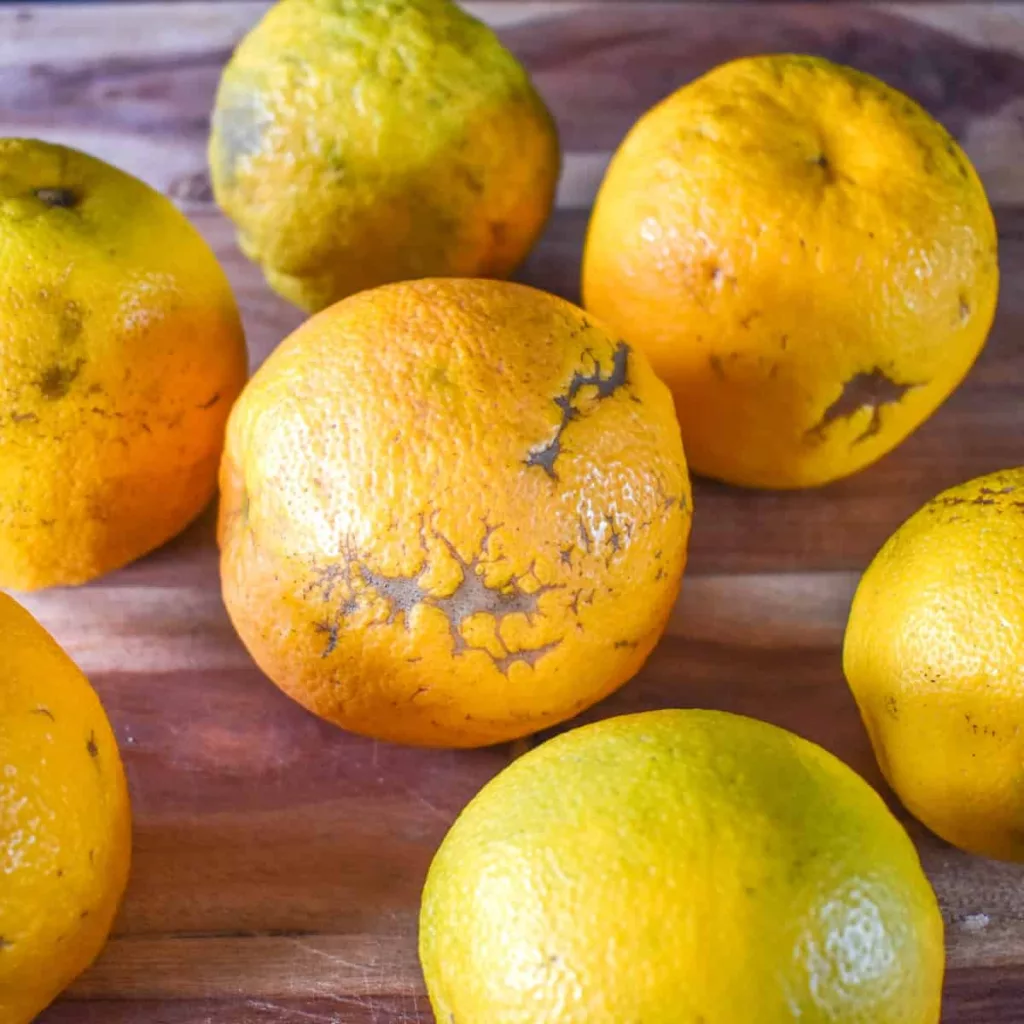
If sour oranges are unavailable, fresh squeezed orange juice and lime juice combined in a 2:1 ratio will work well as a replacement. One part lime juice to two parts orange juice. Thus, one cup of orange juice and half a cup of lime juice would be needed for this dish. Thoroughly shake or whisk to blend.
One more option to think about is sour orange juice in a bottle. You’ll still receive the desired somewhat sweet and sour taste even if it’s not the actual thing. Look for it online and in the foreign aisle of major supermarkets.
Cuban Roast Pork INGREDIENTS
- Pork shoulder: Opt for a large pork shoulder, often known as a pork picnic; 8 to 10 pounds is the recommended weight. Ours weighs nine and a half pounds. If you want to roast something smaller, you’ll need to change how long it roasts for.
- Garlic: For the mojo and the pork, we’ll need two heads.
- Sour orange juice: If sour oranges are unavailable, use bottled sour orange juice (naranja agria) or freshly squeezed orange and lime juice in a 2:1 ratio.
- Olive Oil: Extra virgin olive oil was utilized.
- Spices: salt (kosher salt), cumin, bay leaf, and dried oregano.
You will also need For Cuban Roast Pork:
- Mortar and pestle to breakdown the garlic
- Jar or container with a tight-fitting lid to keep the mojo
- Meat mallet to smash the garlic (or use the side of a large knife)
- Large pan to marinate to pork
- Large marinating or roasting bag or Plastic wrap to cover the pork while marinating
- Large roasting pan with a rack
- Aluminum Foil
- Cooking Spray
MAKE THE MOJO MARINADE
Peel the two garlic heads. For the pork, set aside 8–10 whole garlic cloves.
Smash the remaining garlic cloves using a meat mallet or the side of a big knife. Transfer the cloves to a cutting board and give them a hard smash.
In a mortar and pestle, add the peeled and pounded garlic along with 1 teaspoon of salt. Work the garlic until it becomes flat and tiny bits.
To a medium bowl or jar, add the crushed garlic, sour orange juice, olive oil, oregano, cumin, 1½ teaspoon salt, and the bay leaf. Shake or stir to thoroughly mix. The marinate should be left in the refrigerator for at least an hour, but ideally it should be left in for many hours or overnight. Cover the jar or dish. Before usage, thoroughly shake or mix.
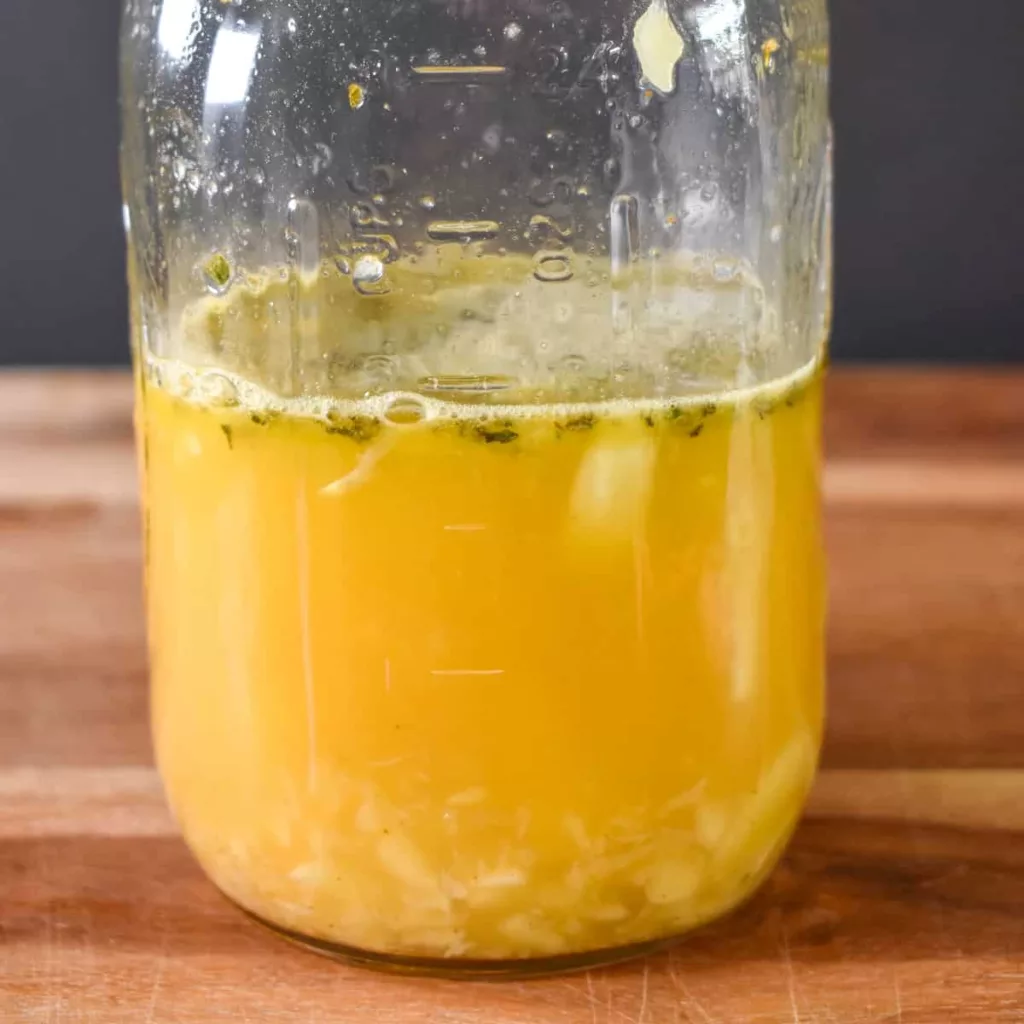
MARINATE THE PORK
We used a huge oven bag to line the pan. They are intended for turkeys, therefore we discovered them in the supermarket’s foil and plastic wrap department. The mojo is inside these bags, which are fantastic since you can knot them shut.
- Put the pork in a big pan, cut 8–10 little holes on the skin side that are approximately 1-2 inches deep, and then slide the saved entire garlic cloves into the incisions. For easier insertion, dip the clove into the marinade.
- After turning the pork over (skin side down), cut approximately 10–12 tiny slits in the flesh, about 1-2 inches deep. Pour the marinade into the incisions you formed using a spoon or ladle.
- Next, cover the pork with the leftover marinade. If desired, season the pork with one teaspoon of salt.
- Once more, flip the pork over so that the meaty side is submerged in the marinade and the skin side is facing upward. Tie a tight knot at the top of the bag to seal it, or cover the pan completely with plenty of plastic wrap. Use several layers, please. This pork is marinating, and the refrigerator will be filled with the intense fragrance. Although the marinade for the pork roast is great, I don’t want days of that fragrance lingering in my refrigerator.
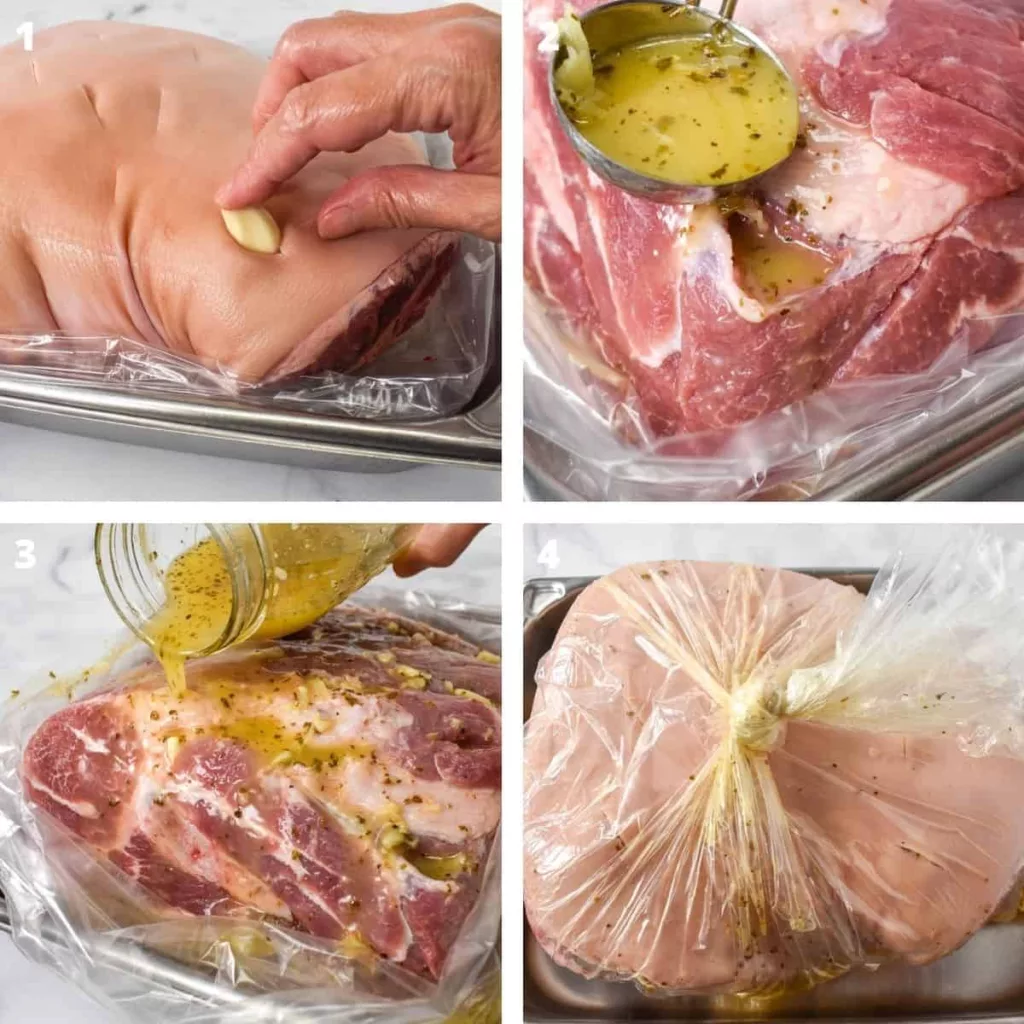
Marinate the Cuban roast pork in the refrigerator overnight.
ROASTING INSTRUCTIONS
If your kitchen is chilly, take the pork shoulder out of the refrigerator 30 to 45 minutes before roasting.
Turn the oven on to 325°F.
To prevent the pork shoulder from resting on the bottom of the pan, use a roasting pan with a rack.
Apply a thin layer of cooking spray to the roasting pan’s rack. With the skin side down, place the pork on the rack. It’s natural for the marinated pork to have a grayish tint; this is the effect of the citrus on the flesh.

Remove any stray garlic granules from the meat. They’ll catch fire very soon. Additionally, add a small amount of water to the roasting pan’s bottom. It will also require you to add a little bit extra when roasting. The garlic and drippings at the bottom of the pan will begin to smoke and burn. This is checked by the water. Throw away any remaining marinade.
Roast the pork for a total of six to seven hours, or until the flesh has torn away from the bone on one end and the internal temperature reaches at least 170° F. Verify the temperature in many locations. Tent the meat for 1½ to 2 hours throughout the roasting process. Loosely cover with a piece of aluminum foil about the size of the pork shoulder. Don’t wrap it; just put it on top.

CRISP THE SKIN
If preferred, you can slightly crisp the pig skin towards the end. After taking the pork out of the oven, carefully turn it over so that the skin side is facing up. This phase requires extreme caution since the roast is hot and heavy.
Pour water into a dish or cup, then generously whisk in one tablespoon of salt for every cup of water. Brush the skin of the pig roast with a small amount of the salty water that has been dripped over it. Repeat many times.
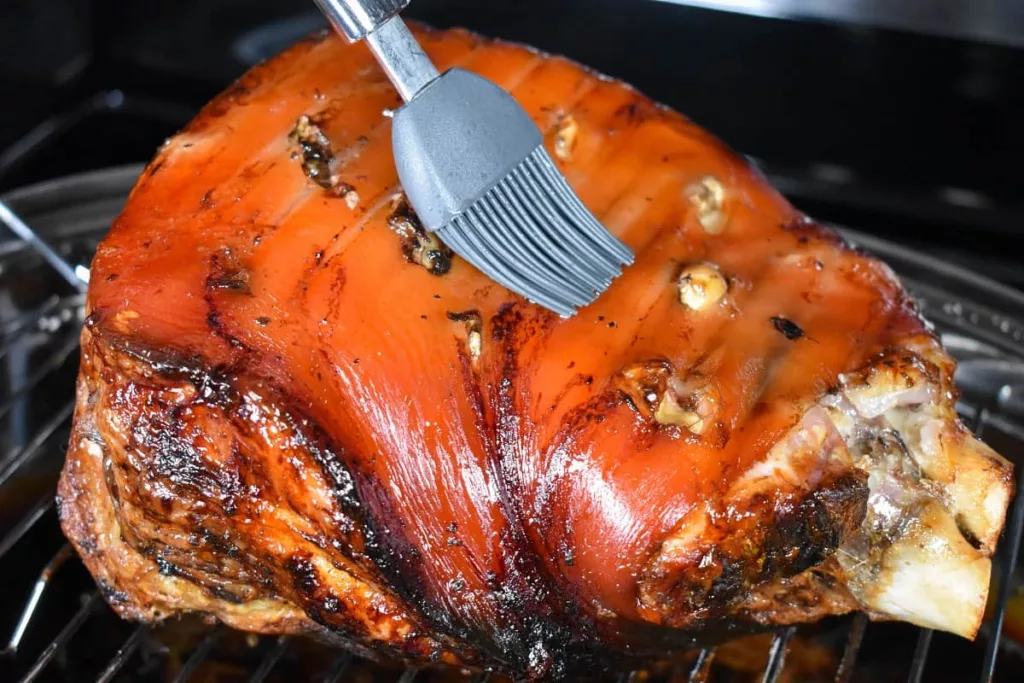
Verify that the pork is not positioned too near the heat source. Take down the rack if necessary. Turn on the low broiler setting on the oven.
Extremely Vital Cook’s Note: After completing this step, do not move from the oven’s side. Activate the oven light and check it around every minute. It’ll be done in two to four minutes. The skin will crisp and brown rapidly; in a matter of minutes, if not seconds, it will turn from a flawless golden brown to scorched.
When the skin is bubbling and beginning to crackle, take the pig out of the oven with caution. Cover the pork loosely with foil and let it rest for at least 20 minutes before cutting.
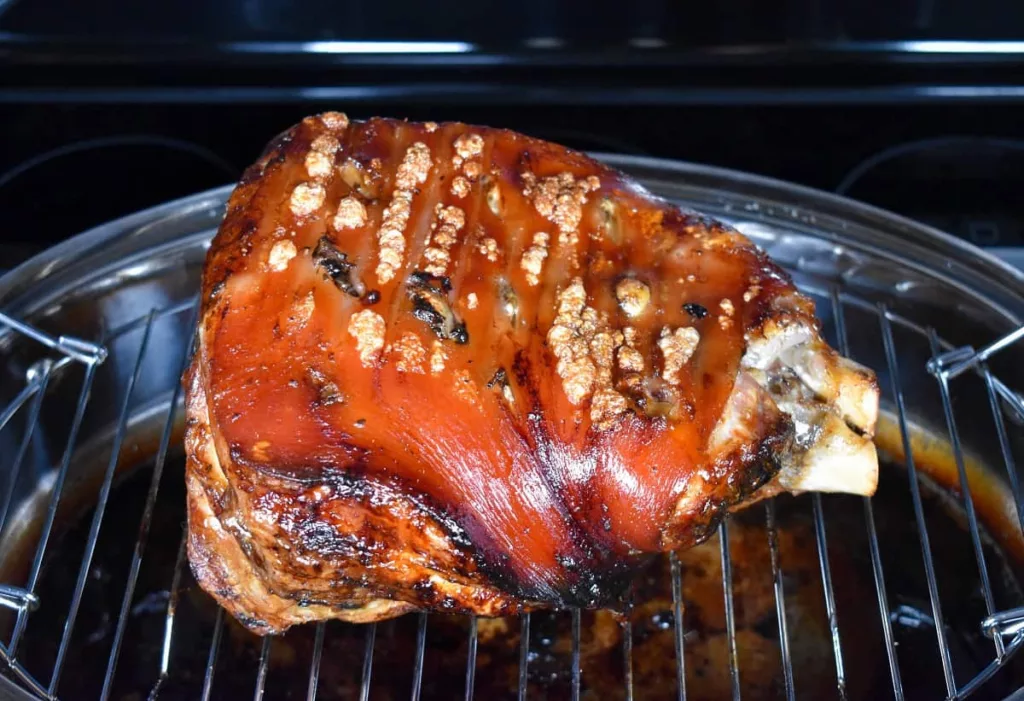
STORING AND REHEATING
Any leftover roast pork may be kept in the fridge for three to four days in an airtight container. To make storing the pork easier, we remove the bone.
The leftovers can also be frozen for up to three or four months in an airtight container.
Reheating the lechon on a skillet works best. We use a large nonstick skillet, so we add a small amount of oil and fry it over medium heat. The pork should be well cooked after a few minutes of cooking in hot oil, flipping it over once or twice.
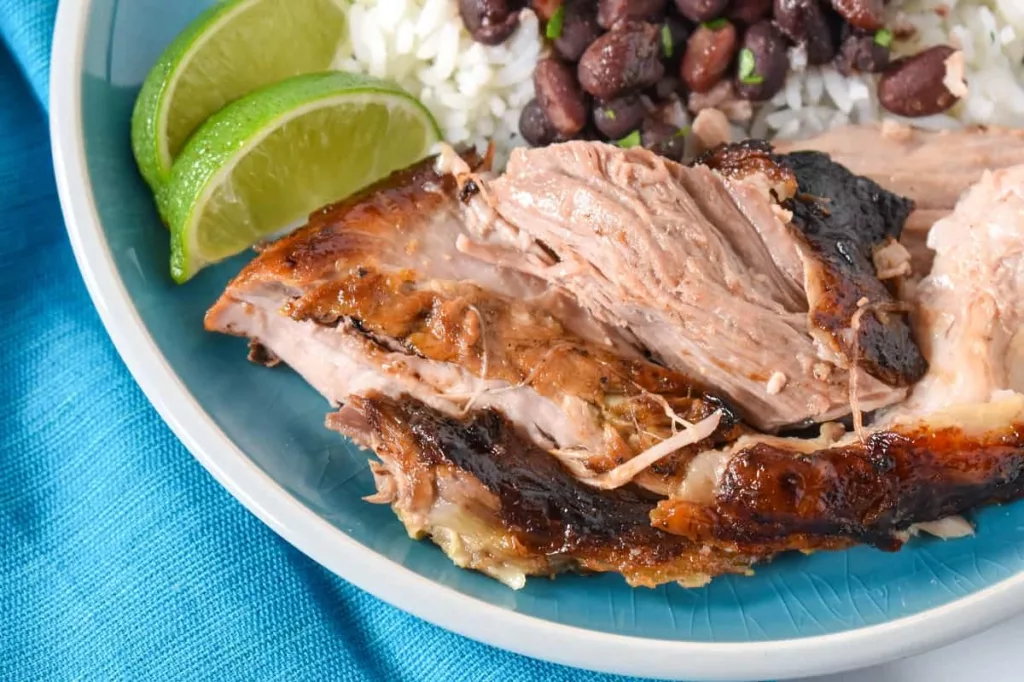
MORE RECIPES YOU MIGHT LIKE

Cuban Roast Pork
Ingredients
- 8-10 pound Pork Shoulder also called pork picnic ours is 9¼ pounds
- 2 Heads of Garlic peeled – divided 1 head for the mojo marinade and 1 head to insert in the pork
- 1½ cups Sour Orange Juice how many oranges to use will depend on how large and juicy they are about 3 pounds
- 2 tablespoons Olive Oil
- 1 teaspoon Dried Oregano
- ¼ teaspoon Cumin
- 1 Bay Leaf
- 2 tablespoons Coarse Salt divided 1 teaspoon to break down the garlic, 1½ teaspoon for the mojo marinade, 1 teaspoon to sprinkle on the pork, about 1 tablespoon for the water to crisp the skin at the end
Instructions
- Additionally, you'll need a mortar and pestle, a jar or container with a tight-fitting lid, a mesh strainer to catch the orange seeds, a meat mallet to smash the garlic (or the side of a large knife), a large pan to marinate the pork, a large roasting pan with a rack, cooking spray, and a large marinating or roasting bag (optional) or plastic wrap to cover the pork while marinating.
Make the mojo marinade
- Peel the two garlic heads.
- For the pork, set aside 8–10 whole garlic cloves.
- Smash the remaining garlic cloves using a meat mallet or the side of a big knife. Transfer the cloves to a cutting board and give them a hard smash.
- In a mortar and pestle, add the crushed garlic and 1 teaspoon of salt. Work the garlic until it becomes flat and tiny bits.
- To a medium bowl or jar, add the crushed garlic, sour orange juice, olive oil, oregano, cumin, 1½ teaspoon salt, and the bay leaf. Shake or stir to thoroughly mix.
- The marinate should be left in the refrigerator for at least an hour, but ideally it should be left in for many hours or overnight. Cover the jar or dish. Give a good shake or stir before using.
Marinate the pork
- If used, line a big pan with the roasting bag. Put the meat in the skillet.
- Cut 8–10 (or as many garlic cloves) thin incisions on the skin side of the pork, about 1–2 inches deep.
- Put the entire garlic cloves that were set aside into the incisions. To make inserting the cloves easier, dip them into the marinade.
- After turning the pork over (skin side down), cut approximately 10–12 tiny slits in the flesh, about 1-2 inches deep.
- Pour the marinade into the incisions you formed using a ladle or spoon.
- Next, cover the pork with the leftover marinade. If desired, add one more teaspoon of salt to the meat.
- Flip the pork so that the skin side is facing up. The meaty side that is marinating is what we desire.
- Tie a tight knot at the top of the bag to seal it, or cover the pan completely with plenty of plastic wrap.
- Let the pork marinate in the fridge for the entire night.
Roast
- If your kitchen is chilly, take the pork out of the refrigerator 30 to 45 minutes before roasting.
- Set oven temperature to 325°F.
- It’s natural for the marinated pork to have a grayish tint; this is the effect of the citrus on the flesh.
- Apply a thin layer of cooking spray to the roasting pan’s rack.
- With the skin side down, place the pork on the rack.
- Remove any stray garlic granules from the meat. They’ll catch fire very soon.
- Add a small amount of water to the roasting pan’s bottom. It will also require you to add a little bit extra when roasting. Any bits of garlic and the drippings at the bottom of the pan will begin to smoke and burn. This is checked by the water. Throw away any remaining marinade.
- Roast the pork for a total of six to seven hours, or until the flesh has torn away from the bone on one end and the internal temperature reaches at least 170° F. Tent the meat for 1½ to 2 hours throughout the roasting process. Loosely cover with a piece of aluminum foil about the size of the pork shoulder. Don’t wrap it; just put it on top.
Crisp the skin (if desired)
- After taking the pork out of the oven, carefully turn it over so that the skin side is facing up. This phase requires extreme caution since the roast is hot and heavy.
- Pour water into a dish or cup, then liberally whisk in 1 tablespoon of salt for every cup of water. Brush the skin of the pig roast with a small amount of the salty water that has been dripped over it. Repeat many times.
- Verify that the pork is not positioned too near the heat source. Should it be necessary, lower the oven rack. Turn on the low broiler setting on the oven.
- Extremely Vital Cook's Note: After completing this step, do not move from the oven's side. Activate the oven light and check it around every minute. It'll be done in two to four minutes. The skin will crisp and brown rapidly; in a matter of minutes, if not seconds, it will turn from a flawless golden brown to scorched.
- When the skin is bubbling and beginning to crackle, take the pig out of the oven with caution. Cover the pork loosely with foil and let it rest for at least 20 minutes before cutting.
Notes
We used a big roasting bag to line the pan. We discovered them in the supermarket’s department dedicated to foil and plastic wrap. If not using a bag, make sure the pork is properly covered with plastic wrap and marinates in the refrigerator. This pork is marinating, and the refrigerator will be filled with the intense fragrance. Use a roasting pan that has a rack so the pork shoulder is not sitting on the bottom of the pan.